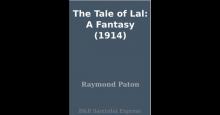


The Tale of Lal
Raymond Paton

Produced by Al Haines
THE TALE OF LAL
_A FANTASY_
BY
RAYMOND PATON
AUTHOR OF "THE DRUMMER OF THE DAWN"
BRENTANO'S CHAPMAN & HALL LTD. NEW YORK LONDON
1914
AN EXPLANATION AND AN APOLOGY
Upon behalf of Ridgwell and Christine the author has been urged toexplain that three things--facts, common-sense, and probability--haveof necessity been throughout entirely omitted in relating this story.The children, however, have comforted the author by declaring thatthese particular things are not required at all in any book of thepresent day, but are merely an old-fashioned survival of the past,which is gradually dying out.
One of the sole remaining examples we possess of fact, common-sense,and probability being the celebration of the 5th of November, which hassomehow become a day of national thanksgiving, and is without doubt oneof the most important dates in the calendar, and very dear to thehearts of the English people.
A PREFACE
The aspect of Trafalgar Square, like everything else in the world,depends largely upon how it is viewed, and through whose eyes it isseen.
A Japanese artist, for instance, visiting London, immediately selectedTrafalgar Square seen by night-time as a subject for a picture. Hethoughtfully omitted any suggestion of either omnibuses, taxi-cabs, orthe populace.
He likewise decided that all the statues were most unpicturesque, andthe varied and flashing electric advertisements to be seen hung up onhigh around the Square were not only hideous but impossible.
Consequently this imaginative being flung upon his canvas a mysteriousblue space, void of anything save the brilliantly coloured lanterns ofhis own land, swung upon bamboo poles, trembling in the darkness atpicturesquely convenient distances. The effect was quite beautiful,but of course it could not in any way be considered as a reasonablelikeness of this particular Square.
A French artist also selecting this portion of London for a picture,determined at once that it would be more becoming, not to saydiplomatic, to paint only one end of the low stone wall surrounding theSquare; yet entertaining doubts afterwards that it might not perhaps berecognised, he added the central stone cupola of the National Gallery,appearing over all like a hastily bestowed blessing, but covered theremaining space upon his canvas with imaginary stalls of glowingflowers, and even more imaginary flower-sellers. His picture wasgreatly admired, and very much resembled the Market Square in Havreupon a Monday morning.
A Spanish artist chancing to pass the same way, likewise hastilycompleted a picture of Trafalgar Square as he wished to see it, addingby way of a decorative effect a lattice-work of trellised vines likeunto his beloved vineyards of Andalusia. Dwarf oranges grew inprofusion and hung their coloured golden globes over the squat stonewalls. A brilliant Southern sun beat upon both, baking the wallsred-hot and ripening the oranges at one and the same time. Thispicture the artist named Trafalgar Square when the Sun Shines.
A Cubist painter, not to be outdone with regard to his point of view ofsuch a subject, covered an immense canvas with wonderful heavingsquares of ochre and green, viewed from a background suggesting endlessmud. This suggestion, however, may have been in the nature of a smalltribute to the usual condition of the London streets. This productionwhich the Cubist artist was optimistic enough to name simply TrafalgarSquare, was instantly bought by a famous geologist, who to this dayindulges in the beautiful belief that he possesses the only indicationof what this particular portion of the world was like before ever theearth was made.
Last of all arrived a Futurist painter, who painted _everything_ inTrafalgar Square, and nothing that did _not_ appear in it. Thepainter, however, selected a really wonderful aspect of the Square,seen from a most strange angle, a sort of bird's-eye view of it, whichcould only have been obtained from a balloon. So remarkable was theperspective that the entire Square, as seen in the picture, appeared asif it were being gradually drawn sideways up to Heaven. The greatNelson column and all the four lions could be viewed simultaneously,and the artist had painted _all the four lions alike_.
Now a Writer whose chambers overlooked Trafalgar Square, and who wasacquainted with its every aspect, by night as well as day, knew fullwell that the Futurist artist was wrong when he painted all the fourlions _alike_. The Writer knew that one Lion was totally differentfrom all the others; so the Writer smiled and kept his own counsel.
I will wait, said the Writer, until somebody else has made the samediscovery that I have made. I will remain completely silent concerningone square patch of fairyland placed within the very hub and centre ofthe Universe, within the busiest part of a great city. When some othertraveller finds the key to the mystic place, we shall both discover itis possible to talk about something which nobody else understands, andbe enabled to compare notes.














